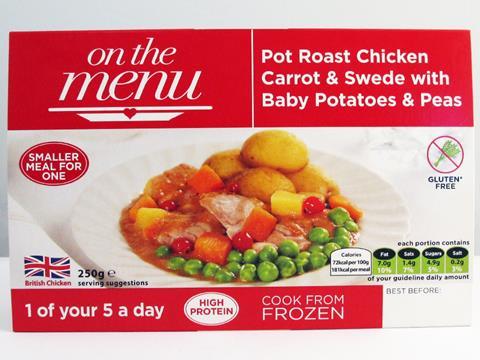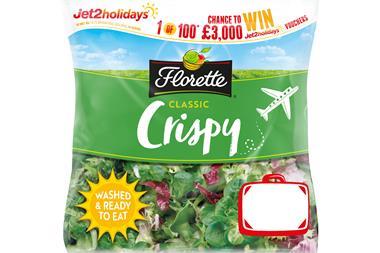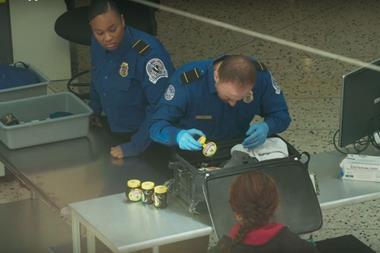The power of the grey pound has never been bigger. Over-50s now hold £1.2 trillion of all the financial wealth in the UK - some 77.3%, according to a report published this year by Saga and the Centre for Economic and Business Research.
That figure will only rise with the introduction of George Osborne’s new pension freedoms. And what’s more, it appears the over-50s love spending their cash on food and drink. ONS data shows while the average under 30-year-old spends £43.40 each week on groceries, 50 to 64-year-olds splash out nearly £20 more and the 65+ category more than £10 more.
“We’re not prescriptive in the sense of saying this is what you should eat.We’re driven by what we have been asked to provide”
That makes the business case for tapping the 50+ market appear self-evident. However “not enough is being done” by the food and drink sector to build on that potential, says Claire Nuttall, founder of The Brand Incubator. Despite targeting the over-50s being a “valid business strategy”, the sector is “lagging behind” the likes of cosmetics and the fashion industry in the race for the grey pound, adds Emily Smith, brand director at marketing consultants Added Value.
So why is food and drink failing to keep pace? And what should brands do if they are interested in a piece of the pension power action?
No garlic!
There are food and drink players out there bucking the trend. Frozen ready meal range On the Menu launched two years ago and targets itself unashamedly at the 65-plus market.
Founder Elizabeth Jones says the catalyst behind the venture was her own elderly mother, Audrey. “We would go to visit her and find nothing in the fridge, or half-eaten meals,” she says. “It stopped me in my tracks and I just thought, if we have been through this the chances are that others are facing the same challenge.”
The result is a range of individually portioned main meals that boast about being a ‘Smaller Meal For One’ (Pot Roast Chicken is 250g compared with an individual Tesco lasagne at 400g). All are based on traditional recipes such as beef ale casserole, and liver in red onion gravy, for which everything from “chewability, to digestive issues, to manual dexterity” has been considered. Such is the level of detail and insight into very traditional British tastebuds that the packs even boast a ‘no garlic’ claim in the ‘free from’ box.

On the Menu was launched to appeal specifically to older consumers. Emily Smith, brand director at marketing consultants Added Value, says although the photography looks like it’s from the 1970s, the pack design has a lot of appealing cues. For example, the oval symbols and red colour feel similar to the ‘Post Office’ brand - trustworthy for the older generation. And the products are suitable for older consumers who want simplistic meat and veg meals with mild tastes they have eaten all their lives. Meanwhile, offering a smaller portion size will also appeal to an older generation that has less of an appetite and doesn’t like any waste.
However, overt ‘for seniors’ labelling was quickly removed after it “bombed” in a focus group, say Jones. “Nobody wanted to be identified as some sort of group over there in the corner that needed to be provided for. And we’re not prescriptive in the sense of saying this is what you should eat, either. We’re driven by what we have been asked to provide.”
Breaking new ground in the category, the brand has taken an “organic route to market”, appearing first in independent stockists “in the heart of the community” before three ready meals in the range secured a listing in 200 Co-operative Group stores.
The Co-op Group was already aware that “preparing healthy meals can become more problematic” for older customers, says Janet Taylor, diet and health manager at Co-operative Food. Particularly those living on their own. That’s why it decided to list a product designed “specifically to meet the needs of older people”.
So far the strategy has paid off with “a loyal brand following”, according to Jones, and year-round continuity in sales. She adds the average basket spend on the range is higher in independent retailers where more of the range is stocked. And although margins can be “challenging” due to the combination of costly home cooked preparation, and lower prices associated with frozen food aisles, Jones continues to believe “it is a burgeoning market with great opportunity.”
So much so that they’re keen to see the concept blown wide open and work with “an inspirational retailer” who shares their vision of specialised aisles for products suited to the older shopper, much as you’d find a dedicated baby aisle in a supermarket.
Jane Vass, head of public policy at Age UK is sceptical about the potential for aisles dedicated to the older shopper, however. “I think there is a real danger about assuming that people want to be categorised in that way. Do we want to ghettoise age?”
Indeed, the risk of homogenising vast swathes of the population may be putting brands and retailers off developing products for older shoppers, Smith believes. “It’s quite a complex world to navigate and a fine line to walk. Older people don’t want to be patronised and buy a product overtly designed for older people as that would make them feel foolish and uncomfortable.”
It’s also vaguely ludicrous to divide consumers by age when it is impossible to generalise a person and their lifestyle in that way, adds Dan Hagen, chief strategy officer at media agency Carat. “We need to stop starting every brief by saying 18 to 34, or 25 to 34, and say we actively want to talk to these people.”
A reluctance to consider the older consumer has led to suppliers and retailers missing key concerns among the 65+ market, many of which were uncovered by an Age UK report into shopping habits.It found bogof and multibuy deals disadvantage the 3.7 million over-65s living alone in the UK; that standard product sizes are too large to facilitate a varied diet; and “age unfriendly” packaging with small print and insufficient colour contrast is prevalent. These are all “recurrent concerns” among older shoppers, says Vass.
Another major concern, according to the Age UK report, is health. In a list of decision-making criteria for 65-plus food shoppers, the charity found health was their prime concern. This prompted On the Menu to tailor its meals to guidelines from the British Heart Foundation and Diabetes UK, and highlight its high protein content front of pack, with the older consumer a fast growing segment seeking out protein enhanced products. Indeed, playing up the health benefits of a product could be one of the most viable routes for new brands looking to enter the category. It’s an approach adopted by the the likes of Benecol, which places its USP of cholesterol reduction at the centre of its marketing, and even runs a dedicated nutrional advice line. Nestlé also launched nutritional drink Boost to explicitly target elderly people at risk of malnutrition .
Despite such examples, John Viccars, head of strategy at RPM, believes there’s a “massive job to be done” in fmcg to improve insight into older shoppers, pointing to a reluctance among brands to “get under their skin”. “The majority of our clients are still very much asking us to focus on profiles that aren’t reflective of who’s actually in the aisle and who’s buying these products.”

The older shopper in numbers:
The proportion of financial wealth in the UK owned by over-50s, according to a report by Saga and the Centre for Economic and Business Research
The number of over-50s living in the UK, over a third of the total population
The proportion of over over-65s living alone in Great Britain, according to Age UK
Of adults agree that once you reach old age, people tend to treat you as a child, according to a report by Age Concern
The average weekly spend on groceries for 50 to 64 year olds, according to ONS data
The proportion of the UK population that will be 65+ by 2034, according to ONS data
The proportion of the current UK population that will live to 100
[Age UK]
Shopping experience
Nuttall agrees there is “too much stereotypical talk” about the habits of older consumers, and it’s evident that standard messaging aimed at a younger profile is often used as a catch-all method. But On the Menu and other pioneers show there is a different way. Dove has developed “specific communications that target older women,” says Smith, accompanied by a portfolio of products that allow it to accompany consumers on a “journey through life”.
In doing so, she says, it has moved away from a culture in which youth “is the ideal, and old age is seen as a downward spiral towards death”. Similarly, Pepsi has created a “platform to try and attract an older audience” with its Forever Young campaign.
Nuttall also believes there’s an opportunity for “more integration with food brands and healthcare providers” such as Bupa and Saga. “It’s an easy thing to embrace and be part of,” she adds, and would create a “much stronger, more powerful proposition.”
Of course, it isn’t just brands that have work to do. Older shoppers struggle with “poor store layouts” in supermarkets, according to the Age UK report, due to narrow aisles, insufficient shelf signposting, shelves that are too high or too low, and a lack of rest places.
“The shopping experience is poor for older shoppers,” says Nuttall. “There are very few things done in store to help older consumers see what they need quickly, reach for shelves or sit down if they feel weary.”
Some retailers “naturally lend themselves to an older consumer”, adds Smith, while a shift toward convenience shopping could mean store improvements that will benefit the age group. However “the retail environment is probably going through the most volatility it has ever gone through, and the desire to engage in older populations is not what is driving that,” warns Hagen.
In other words, it isn’t high enough on the agenda, and Age UK urges both brands and retailers to look at reappraising their priorities.
Ultimately, the “smart brands will get behind this age group, give them platforms to speak and experiences to talk about”, says Bernadette Morrison, associate strategy director at retail and brand consultancy Fitch. Not least because with the proportion of over-65s set to rise in the UK from 17.7% to 23.5% by 2034, their voice is only going to get louder.






















No comments yet